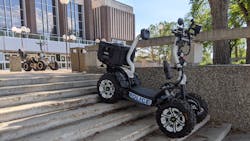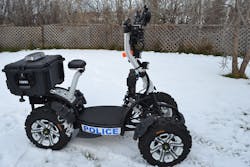Saddle Up: Re-Envisioning the Horse as an Alternative Vehicle for Officers
The idea for the all-electric LyteHorse started out as just that. The brainchild of brothers Allen and Brad Bonk from Regina, the capitol city of Saskatchewan, Canada, was born on the golf course as a fun way for golfers to navigate their way from hole to hole. But once the duo realized the military and law enforcement applications, they expanded their vision and the capabilities of the machine.
“It was fun, it was great, and I just saw more applications for it. So, we did some crazy things, like we hooked it up to my SUV in a parking lot just to see what would happen and sure enough, it dragged it all over the place,” says Allen Bonk, CEO of LyteHorse Labs. “Then I thought ‘This has got some legs to it and some application potential outside of golf.’ ”
Brad Bonk, the company’s CDO and the brains behind the design of the initial prototype, was able to dig into his creativity and constructed a form factor his brother says has never really been seen before. “Once we started building it, the sort of use innovations for law enforcement was evident very quickly.”
‘Modern day horse’
Allen Bonk says the inspiration for the LyteHorse comes from the animal itself. The idea is to put the operator at a higher vantage point while still providing needed stability. “The current situation that we see all around us every day, which is riots and protests and large gatherings, and the only way that law enforcement has to really get the vantage point that they need is from horseback,” he says. “The advantage from horseback is obvious and that’s why you see them deployed, but the challenge is with that approach is that horses are very slow to deploy, they’re very expensive to maintain and keep and they require a lot of training for the mounted officers to use them properly.”
The deck height of the LyteHorse is 17 inches from the ground, which takes a 6-foot police officer and makes him or her just under 8 feet tall. “Now you have a decided advantage because you are quick to deploy, there’s no emissions—by that I mean stink—and you’ve got absolute stealth. It’s very quiet and the machine is also very intimidating. It’s hard to get a grasp of the scale and the size of the machine from the pictures and the videos,” says Bonk.
Drew Bartkiewicz, CEO of Patriapps Ventures, which is a distribution and development partner of LyteHorse Labs, echoed Bonk’s sentiment. “When I walked into the lab and I first saw it, from a distance, I thought it was on a platform or a shipping pallet because it looked like something out of the movie Terminator. As I turned the corner, and I got closer to it, I realized that was actually the vehicle on the ground. I stepped up on it and I went from 6 feet to 8 feet tall. Really, the minute I pressed the button to move forward, I said ‘This thing is going to change mobility as we know it.’ This is the modernization of the horse.”
The machine can reach speeds of up to 40 mph and is able to maneuver over and around curbs, steps and other obstacles. Bonk touted the LyteHorse’s unique footprint. The front wheels are 10 inches wider than the rear wheels, providing a layer of stability that he says is uncommon in a ATV, quad or other 4-wheelers.
“To push that machine over takes a lot of work. It’s very challenging to do. It becomes very stable. It’s stable on corners because the front wheels sort of work like outriggers on a canoe and provide that level of stability that you wouldn’t get if the wheels were all parallel and in line with each other. In an off-road situation, the rear wheels are always in fresh terrain, so they don’t follow in the ruts or the tracks if you are in mud or something like that. It’s very agile and can go most places and climb hills.”
Advanced technology
While at first glance it may appear the LyteHorse has some similarities to an ATV, quad or even a Segway, Bonk says that his machine is much different in many ways. It has independent motors on each wheel, and it doesn’t have a drivetrain. It has an independence of the four hub motors and there is no driveline to run them. Bonk says that the failure rate is low and the maintenance is virtually zero, aside from checking the air pressure in the tires.
“Our approach is far superior because you have multiple redundancies. If you’re off in the backwoods with a quad and something happens on one of the drivelines, you are walking out, but that is not the case with the LyteHorse,” he says.
The LyteHorse will run off of battery packs called LytePacks that are 2.5 kilowatt-hours each, and the vehicle will carry four of them under the deck. All four LytePacks will last about 80 miles in ideal conditions. The law enforcement version will include a box that can carry another four LytePacks, as well as other equipment. There will also be trailer accessories that will carry an additional eight LytePacks. Charging is simple as the charger is plugged into a one-pin and will also have an option for public charging stations.
Bonk stresses that the way the machine is constructed insures that it will be able to operate without requiring major maintenance. “The machine has very sophisticated bushings that come out of Germany that are used in Caterpillars. It takes 8,000 hours of use before you even need to look at them. That’s through saltwater, dust, sand and whatever else could get in there,” he says. “There are less moving parts on the machine than on a bicycle, which translates to super low failure and law maintenance. It’s just plug-it-in and go.”
A focus on stability
Since operators aren’t strapped in, the design of the LyteHorse put a lot of focus on the stability of the vehicle. There are upward-angled footboards that are 6 inches below the main deck on both sides of the vehicle that are designed ergonomically to stand on when you want to get down and dirty and climb stairs or go over curbs or off-road terrain. “They add a level of stability to the machine that is phenomenal,” Bonk says. “You are lowering your center of gravity and you are distributing your weight out to the sides.”
Bonk says that he has gone as fast as 55 mph on the machine and didn’t feel the least bit worried or nervous at a rate of speed that is considerably faster than what it would be intended to go up to. “You can hit bumps at any speed, the suspension is so fantastic.”
Also, if the operator decides to jump off of the LyteHorse, it will come to a running stop all by itself. As soon as the officer lets go of the throttle, the brakes start to apply and—depending on the speed the vehicle is going—it will come to a stop in about 15 feet.
Military and policing applications
For the military version, LyteHorse Labs has designed a V-shaped skid plate for underneath the vehicle that would disperse the impact if it runs over an IED. “If you think about why soldiers get injured, it is because they are in a Humvee typically and they’ve got nowhere to go,” Bonk says. “They are in a cage. The soldiers unfortunately have to take on the impact of whatever the IED is and they can’t get out. With the Lytehorse, the whole design philosophy of that type of application is that soldier would be thrown clear. He’s not trapped, he gets ejected from the machine.”
Bartkiewicz, a former military officer, was deployed in Iraq in 1991 with the 82nd airborne as part of a combat mission. “We lugged around in large Humvees, which in many cases where an over-application of mobility,” he says. “During combat, those Humvees were great. During the policing function that we then encountered—I remained on as part of a kind of a police force that really helped the Kurds migrate back from Turkey into northern Iraq—when I looked at the policing application of the Humvees, they were over-mobility. Taking one or two people in a Humvee with the increased footprint of hitting mines or IEDs, really you had way more body of a vehicle than you needed.
“When I was exposed to the LyteHorse about a year ago, I reflected back at both the combat as well as the police applications I had in the military. I thought that the LyteHorse was really something that no one had ever conceived as a new form factor,” he says. “Just showing the presence of a police officer on a LyteHorse to me sets the right optics.”
Looking to the future
LyteHorse Labs plans to have units coming out of production by the end of spring at its headquarters in Regina and at its manufacturing partner Mayco’s facility in Sterling Heights, Michigan.
So far, the company has spoken directly with the Regina Police Department and an advisor with the company who is a former LAPD officer has made contact with about a dozen other law enforcement departments about adding the vehicle to their fleets.
About the Author
Paul Peluso
Editor
Paul Peluso is the Managing Editor of OFFICER Magazine and has been with the Officer Media Group since 2006. He began as an Associate Editor, writing and editing content for Officer.com. Previously, Paul worked as a reporter for several newspapers in the suburbs of Baltimore, MD.


